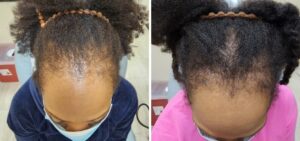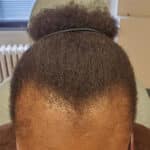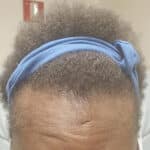Traction alopecia: when is it too late to treat? Although hair loss specialists recommend getting help sooner than later, you may have more time than you thought to get help.
What is Traction Alopecia?
Traction alopecia is a type of hair loss caused by prolonged tension on the hair shafts, leading to damage to the hair follicles. This condition often results from certain hairstyling practices that exert excessive stress on the scalp. Over time, this persistent pulling can weaken the follicles and disrupt normal hair growth, cause scalp inflammation, thinning, breakage, and in severe cases, permanent hair loss. Most commonly the condition presents as a thinned hair line, or as some describe as a loss of one’s “edges.” Depending on where the tension is this type of hair loss can occur anywhere on the scalp. Traction alopecia is particularly common among African American women and girls and ballerinas who wear tight buns. It can, however, affect anyone who frequently wears tight or heavy hairstyles.

Hairstyles That Cause Traction Alopecia
Some hairstyles are more likely to cause traction alopecia due to the tension they create on the scalp. These include:
- Tight braids: Cornrows and box braids, especially when styled with added hair extensions.
- Ponytails and buns: High and tight ponytails or buns, often worn by athletes like ballerinas, can lead to stress on the edges and crown.
- Weaves and wigs: Sewn-in weaves or wigs with adhesive that tugs on the hairline.
- Dreadlocks and twists: When dreadlocks are excessively heavy or tightly pulled.
- Hairpieces and clips: Regular use of tight clips, headbands, or extensions that pull at the roots.
These styles can lead to a receding hairline and thinning edges if worn repeatedly over long periods. To grow your edges back faster and protect your scalp, it’s crucial to minimize the use of such styles or ensure they’re not overly tight.
Early Traction Alopecia
In its early stages, traction alopecia is often reversible. Common signs include:
- Redness and tenderness: Irritation of the scalp from constant tension.
- Small bumps: Follicular inflammation, often seen around the hairline.
- Thinning hair: Noticeable hair thinning, especially at the temples and edges.
- Breakage: Short, brittle hair strands near the areas of tension.
If detected early, removing the source of tension and adopting gentler hair care practices can help the hair grow back. Medical treatments such as injected or topical steroids, minoxidil, PRP or Alma TED can also help but may not be needed.
Late-Stage Traction Alopecia
As traction alopecia progresses, the damage becomes more severe and harder to reverse. Late-stage signs include:
- Bald patches: Visible areas of complete hair loss.
- Scalp scarring: Shiny or smooth areas indicating permanent follicle damage.
- Thickened scalp: Over time, prolonged inflammation can lead to fibrosis of the scalp tissue.
At this stage, natural regrowth is unlikely, and medical interventions may be necessary to restore hair. This is when medical treatments such as injected or topical steroids, minoxidil, PRP or Alma TED are needed.
Signs of Permanent Traction Alopecia
Permanent traction alopecia occurs when hair follicles are irreparably damaged. Key indicators include:
- Lack of regrowth: No signs of hair returning after months of reduced tension and medical treatment.
- Scar tissue: The presence of scarred areas on the scalp where follicles have been destroyed. The scalp may appear shiny.
- Uniform hair loss: Persistent thinning or balding patterns that don’t respond to traditional hair care remedies.
If you suspect permanent traction alopecia, after attempting medical treatment, a hair transplant may be needed.
Traction Hair Loss and CCCA
Central centrifugal cicatricial alopecia (CCCA) is another form of hair loss that can sometimes overlap with traction alopecia. The two are often found together. CCCA is a progressive, inflammatory scalp condition that leads to scarring hair loss, primarily affecting African American women. CCCA typically starts on the top of the head and spreads out over time. It starts with traction on the scalp in a vulnerable person who continues to have flare ups even after the tension is gone. Symptoms of CCCA include:
- Burning or itching scalp: Persistent discomfort in the crown area.
- Progressive hair loss: Beginning at the crown and spreading outward.
CCCA is more common in people with a history of fibroids, keloids and diabetes.
How to Treat Traction Alopecia
Treating traction alopecia depends on the severity of the condition. Here are some steps to consider:
- Stop the Tension:
- Immediately switch to loose, protective hairstyles to prevent further damage.
- Avoid heavy extensions, tight buns, or any style that pulls on your scalp.
- Promote Healthy Growth:
- Use hair growth serums containing ingredients like minoxidil.
- Incorporate a balanced diet rich in vitamins and minerals that support hair health, such as biotin, zinc, and iron.
- Stimulate the Scalp:
- Regular scalp massages can improve blood circulation and encourage follicle health.
- Medical Treatments:
- For advanced cases, consult a dermatologist for treatments like corticosteroid injections, Alma TED or platelet-rich plasma (PRP) therapy.
- In cases of permanent hair loss, surgical options like hair transplants may be considered.
Why See an Alopecia Specialist
Traction alopecia- when is it too late? Consulting an alopecia specialist is vital for proper diagnosis and treatment. Here’s why:
- Accurate Diagnosis: A specialist can distinguish between traction alopecia, CCCA, and other forms of hair loss.
- Customized Treatment Plans: Specialists can recommend tailored treatments, including medical therapies and lifestyle changes.
- Prevent Further Damage: Early intervention can halt the progression of hair loss and save remaining follicles.
- Advanced Solutions: For severe cases, a specialist can discuss options like Alma TED or hair restoration surgery.
Traction alopecia is a preventable and often treatable condition if addressed early. By being mindful of hairstyling practices and seeking timely medical advice, you can grow your edges back faster and maintain healthy, strong hair. If you suspect you’re experiencing traction alopecia, don’t wait—schedule a consultation with our alopecia specialist today.




